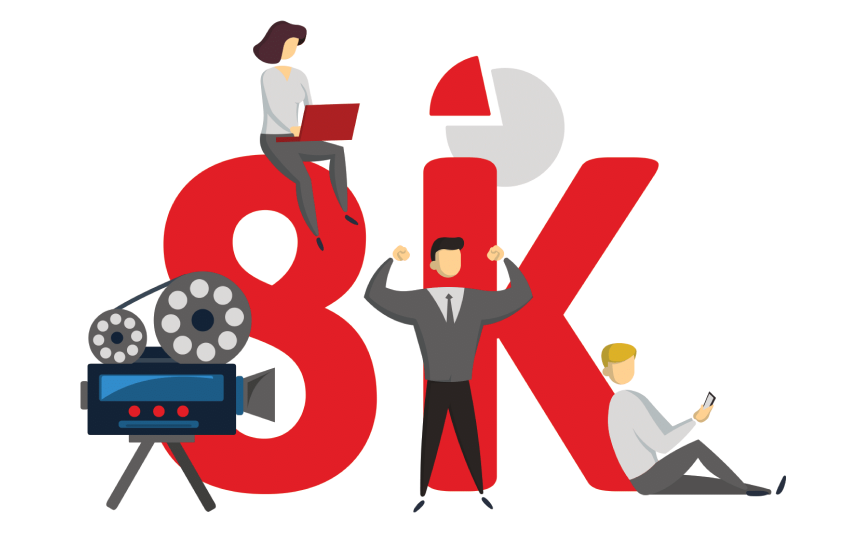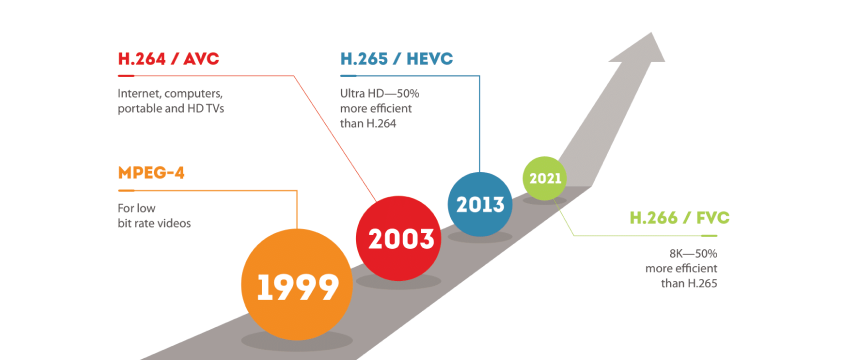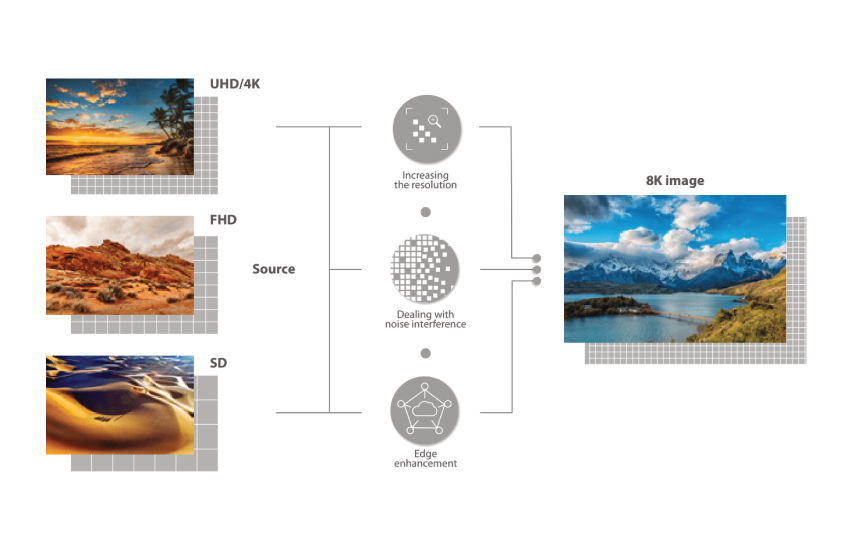Product request
You are looking for a solution:
Select an option, and we will develop the best offer
for you
8K: AHEAD OF TIME

4K is just on the verge of becoming a market standard, but its successor, 8K, has already arrived and it’s running into problems. For one thing, provider networks aren’t ready for new bit rates. At present, the equipment is expensive, and there is not enough content. But can 8K change the IPTV/OTT sphere?

The terms 8K, Full Ultra HD, and 4320p all refer to 7690×4320 pixel resolution The standard has four times as many pixels as 4K and 16 times as many as Full HD. The technology is officially promoted by Samsung, Hisense, and TCL, all of which are members of the 8K Association.

«The Association develops an ecosystem and popularises 8K products».
Dr. Weidong Liu, leading Hisense researcher
The new standart: features

Even from a few centimetres away, pixels are indistinguishable on the 8K display with a diagonal of 70 inches. From this distance, the viewer will see only a fuzzy, granular image on a comparable Full HD display. But the difference between 8K and 4K isn’t critical: the differences aren’t noticeable if you are viewing them from the same distance.

Most viewers watch TV at an average distance of 2.63 m from the display. This distance hasn’t changed since 2004, although the size of the display has increased significantly.
Source: BBC Research & Development
It is impossible to sense the difference between UHD and Full UHD at this distance, even on a display with a 55” or 65” diagonal. The differences can be seen only on devices with diagonals of more than 75”. In 2022, the price of an 8K TV with a 75” diagonal is likely to drop to $2000; a similar 4K device will cost half as much.

Demand for big displays will only increase: according to Statista, in 2009, only 7% of households had a TV with a diagonal larger than 49”; in 2019, every third house had a TV this size.
4K has quickly gained popularity: the prices of the new-standard TVs have declined rapidly, and their sales have steadily increased since these devices hit the retail market seven years ago. IHS predicts that by 2022, six out of ten households in North America and 40% of homes in Western Europe will have a 4K TV.
Worldwide sales of 4K TVs, mln (OVUM)

8K TVs appeared later. Sharp demonstrated its prototype at CES in Las Vegas in 2012. LG introduced an 8K model at IFA in Berlin in 2014. At that time, Samsung presented its 8K TV. In addition to these, retail models are also being offered by Sony, Hisense, and TCL in 2019.
In 2024, forecasts indicate that 269 million TVs will be sold, and the share of 4K devices will reach 78%.
Source: IHS Markit
Main issues associated with 8K
The introduction of the new standard is hampered by the same problems that plagued 4K five or six years ago and Full HD prior to the introduction of 4K. Neither the IPTV/OTT operator networks nor the physical media were ready for the new bit rates. Currently, there is almost no compatible content, and 8K devices are inaccessible to most users.
Infrastructure is not ready

To watch content in 8K, the viewer needs not only a suitable TV but also a dedicated satellite or high-speed broadband connection. Delivery of content at this resolution requires completely new technologies and infrastructure. Streaming videos in 4K requires a connection with a speed of 15–25 Mbit/s. With 8K, you need six times more bandwidth 80 to 150 Mbit/s. Most families have more than one television. If the devices work simultaneously, stable streaming requires a 1 Gbit/s connection. Internet providers cannot offer this.
The average speed of mobile networks in 2019 is 26.1 Mbit/s, for fixed-line networks, it is 57.9 Mbit/s
Source: Speedtest Global Index
Streaming services: recommended connection speed

The 4K standard has also faced problems associated with infrastructure and media. It was impossible to compress UHD videos to a bit rate that allowed them to be transmitted through existing networks, especially mobile networks. To fix this, the Joint Collaborative Team on Video Coding (JCT-VC) developed an HEVC codec (h.265), which was standardised in 2013. The codec became the successor to h.264 and allowed videos to be compressed twice as much without losing image quality.

There are no suitable physical media. Even a compressed film in 8K takes up a few hundred gigabytes, and maximum-capacity Blu-ray discs contain only 100 GB.
HEVC has accelerated the introduction of 4K, and the impetus for 8K could be the format that evolves from it — the FVC (Future Video Codec). Its developers promise the new codec will be able to compress video 50% more efficiently. By October 2019, the test version of H.266 will be released, and by June 2021, the first hardware codecs will appear.

Manufacturers of HDMI cables are ready for the introduction of 8K. In November 2017, the HDMI 2.1 standard was released, which supports 8K transmission at 60 fps. More importantly, the technology allows 4K HDR transmission at 120 fps.

Lack of content
Films and TV shows are currently made in 8K. For example, The Hobbit trilogy, House of Cards, and Guardians of the Galaxy Vol. 2, were shot in this new resolution. Japan and Italy have already launched FUHD channels covering major sporting events like the Olympic Games. But there is not enough content. However, there is no lack of content in the 4K standard. The main streaming players like Netflix and Amazon Prime Video have a stake in 4K. For example, the Netflix database has 630 films and TV shows available in 4K. Linear television is keeping up as well: there are 142 UHD channels with regular broadcasting in the world. Fortysix of them are broadcast in Europe. Rakuten TV is the first streaming service that promises to introduce 8K, but this won’t happen before 2020.
4K: the number of films and TV shows released on Blu-ray

More than 200 titles are released on Blu-ray every year.
Source: HD Report
Thankfully, the problem has a solution: 8K TVs increase resolution programmatically. For example, the neural network of Samsung devices has been trained by sampling of millions of images of different resolutions, which allows it to generate missing pixels. The system automatically ‘fills in the gaps’ in the image and improves the quality up to Full UHD.

Other applications of 8K
This technology is already being applied in medicine. Endoscopes with high-resolution cameras can be used to examine patients and these devices can even be operated them in a minimally invasive way. High resolution is also used in virtual reality (VR), where it is important to be able to zoom in on images with no loss of quality. Even at 16× magnification, VR images maintain Full HD quality.

8K has great potential, but in the coming years, Ultra HD will remain the standard. The amount of content is growing; networks are ready for new bit rates, and modern 4K TVs are available to viewers. The prices for Full HD and 4K set-top boxes are almost equivalent now, so IPTV/OTT operators are launching projects based on more modern devices.
Recommended

IPTV and E-commerce: Prospects of Built-in Online Stores on the TV Screen
Over the past few years, IPTV platforms have gone beyond being merely a channel for delivering television content.

How to Properly Organize Backup Servers for IPTV Streams
The IPTV and OTT market is growing rapidly, with the quality of broadcasts continuing to improve, the number of channels increasing, and the functionality of set-top boxes and applications expanding.

The Evolution of Codecs: From H.264 to AV1 and VVC — What Should Operators Choose?
Over the past decade, the video market has undergone a rapid shift from linear TV to flexible IPTV/OTT services, where image quality and delivery efficiency play a crucial role.










